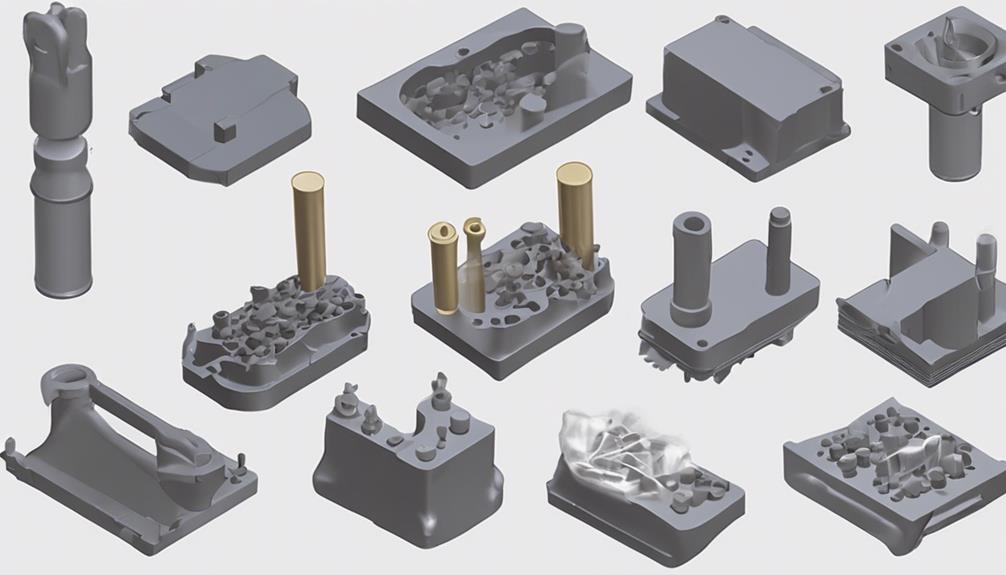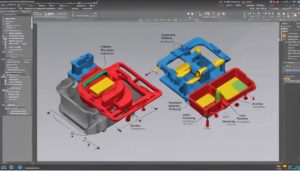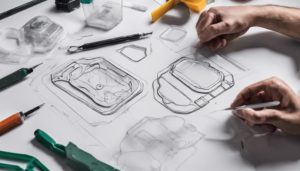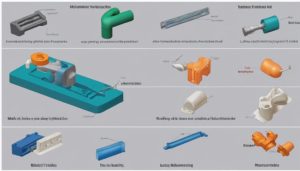Plastic injection molding involves melting plastic resin pellets in a machine and injecting the material into a mold cavity under pressure. Temperature and pressure control are essential for consistent results. The molten material fills the mold cavity precisely, aided by high pressure for uniformity and minimizing air bubbles. Cooling solidifies the material to the mold's shape, ensuring dimensional accuracy. Proper execution is important for high-quality plastic components. The process offers precision, repeatability, and efficiency, with the role of a rotating screw being critical. High pressure is fundamental for thorough mold filling. Understanding this detailed process enhances comprehension of plastic molding intricacies.
Understanding Plastic Injection Molding
Plastic injection molding, a sophisticated manufacturing process, entails the precise melting and injection of plastic resin into molds to produce diverse products efficiently and with high accuracy. During the injection phase, the plastic resin pellets are heated to a specific temperature within the injection molding machine. The temperature is carefully controlled to guarantee the plastic reaches a molten state suitable for injection into the mold.
Pressure plays a vital role in the injection process as well. Once the plastic is molten, a controlled amount of pressure is applied to inject the material into the mold cavity. The pressure must be accurate to fill all sections of the mold properly and avoid any defects in the final product.
Maintaining the correct temperature and pressure throughout the injection process is essential for achieving consistent results in plastic injection molding. This precision in controlling temperature and pressure allows for the production of high-quality plastic products with complex shapes and details.
Heating Plastic Granules for Melting
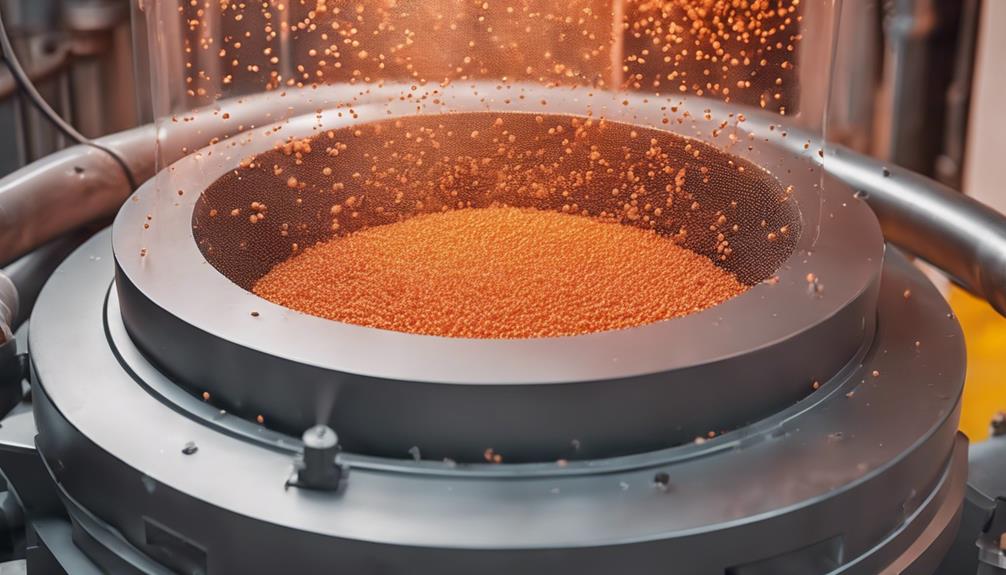
In the injection molding process, the controlled heating of plastic granules in the machine's barrel is a vital step that facilitates uniform melting and efficient flow for molding operations. Plastic granules are heated to a specific temperature within the barrel, where the screw applies pressure and friction to melt the plastic uniformly. This process guarantees that the plastic material is in a molten state, ready for injection into the mold cavity.
Temperature control plays an essential role in heating plastic granules for melting. Maintaining the correct temperature is vital to prevent issues such as overheating or underheating of the plastic material. Proper temperature control ensures that the plastic flows smoothly and uniformly, filling the mold cavity accurately to produce high-quality parts.
Once the plastic granules have been melted to the desired state, they are injected into the mold cavity. This molten plastic material takes the shape of the mold, solidifies, and forms the final product through the cooling process.
Injecting Molten Material Into Mold
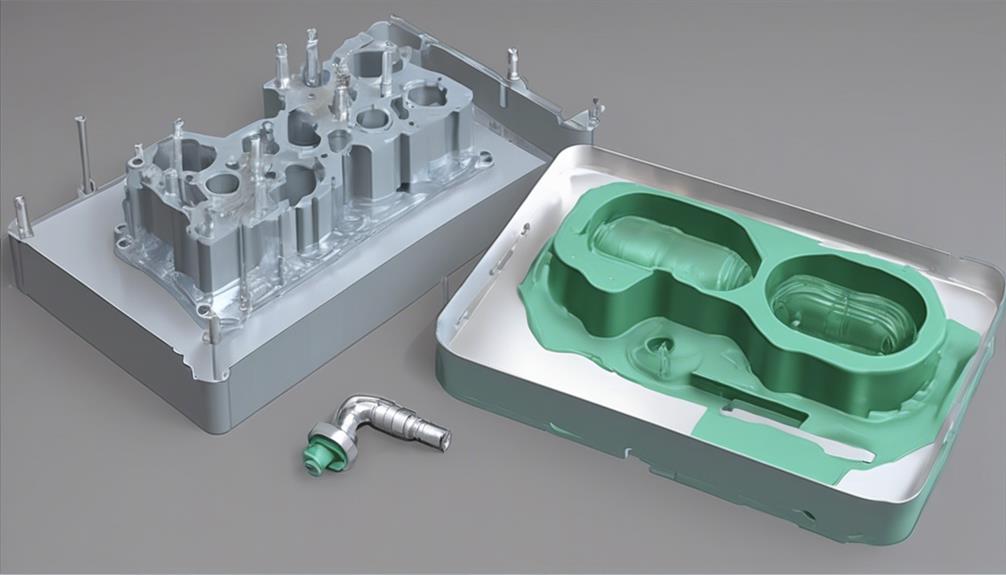
The process of injecting molten plastic material into the mold involves a meticulously controlled mechanism to guarantee complete mold filling.
Temperature regulation during injection is vital in maintaining the material's viscosity and flow characteristics.
The molten material is injected under high pressure, allowing it to solidify and take the shape of the mold cavity, forming the desired plastic component.
Molten Material Injection Process
With precision and controlled pressure, the molten material is meticulously injected into the mold cavity to shape the desired product. As the mold closes, the molten material is forced into the mold through the gate under high pressure. This pressure applied during injection is vital for ensuring the material fills the mold completely and uniformly. It also helps in packing the material tightly to minimize the presence of air bubbles, which can affect the quality of the final product.
Following injection, the molten material initiates the cooling process, solidifying to take the shape of the mold. The cooling process is essential for setting the material in its final form and ensuring dimensional accuracy.
Mold Filling Mechanism
Utilizing a gate system for controlled regulation, the mold filling mechanism in injection plastic molding precisely directs molten plastic material into a pre-designed mold cavity. This process involves specific steps to guarantee the successful creation of plastic components:
- Pressure Application: Pressure is applied during injection to ensure that the mold cavity is entirely filled with the molten material.
- Mold Halves: The mold, consisting of two halves, securely contains the molten plastic during the filling process.
- Cooling Phase: After the mold cavity is filled, the injected plastic material undergoes a cooling phase. This phase allows the material to solidify and take the shape of the mold accurately.
Proper execution of the mold filling mechanism is essential for achieving high-quality and precise plastic components in the injection molding process.
Temperature Control During Injection
Precision in managing the temperature of the molten material plays a critical role in ensuring the integrity and quality of plastic components during the injection molding process. Maintaining precise temperature control is essential to prevent defects such as warping or incomplete filling of the mold.
Variations in temperature can greatly impact the flow behavior and viscosity of the molten plastic, directly affecting the final product's integrity. Advanced temperature control systems integrated into modern injection molding machines accurately regulate the heating and cooling of the material.
Proper temperature control is key to achieving the desired mechanical properties and surface finish of the injected plastic components, highlighting the importance of maintaining ideal temperatures throughout the injection process.
High-Pressure Molding Process
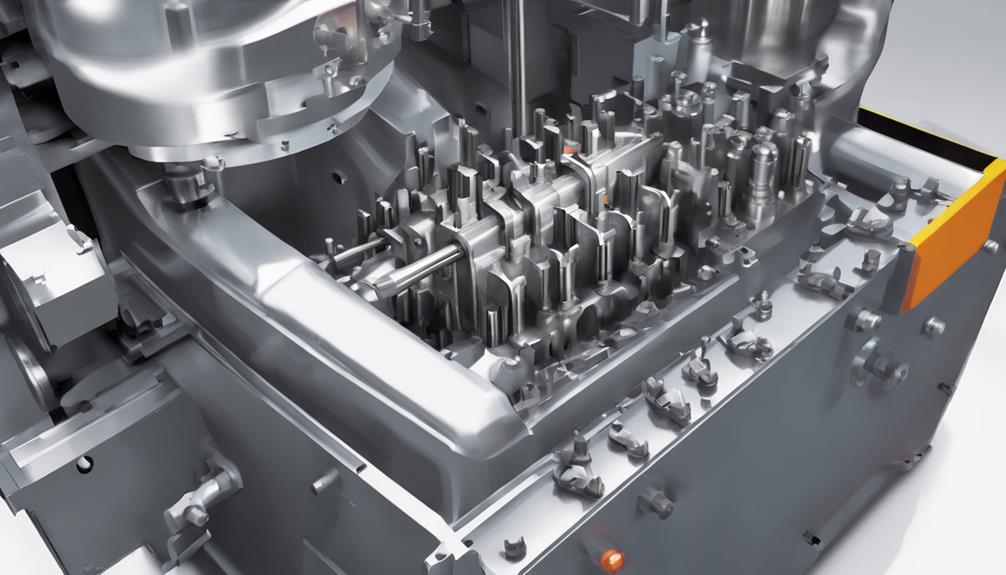
The high-pressure molding process in injection plastic molding is crucial for achieving precise and detailed plastic components. This method guarantees that the molten plastic completely fills the mold cavity, taking on the desired shape.
High pressure is maintained until the plastic cools and solidifies, resulting in consistent quality and accuracy in mass-produced plastic parts.
Mold Design Basics
In high-pressure injection molding, the design of the mold involves the creation of precise cavities and cores essential for shaping the final plastic product. The mold design must carefully consider factors such as part geometry, cooling requirements, and material flow to guarantee excellent production outcomes.
- Material Flow: The mold design dictates how the molten plastic material moves within the mold to fill the cavities adequately.
- Cooling Channels: Integrated cooling channels help regulate the cooling rate of the plastic to guarantee proper solidification and dimensional stability.
- Part Geometry Consideration: The mold design must accommodate the intricate details and specific geometry of the final plastic part for accurate reproduction.
Plastic Injection Process
During the plastic injection process, high-pressure molding techniques are employed to inject molten plastic into a precisely designed mold cavity. This injection molding process necessitates the application of high pressure to guarantee that the mold cavity is entirely filled with the molten plastic material.
Once the plastic is injected into the mold, it is left to cool and solidify, taking the shape of the mold. High-pressure molding allows for the production of intricate and detailed plastic components with exceptional precision. This method is favored in various industries for its efficiency, consistency, and cost-effectiveness.
Plastic injection molds play a vital role in this process, enabling the creation of a wide range of plastic products with consistent quality and accuracy.
Solidification Within the Mold
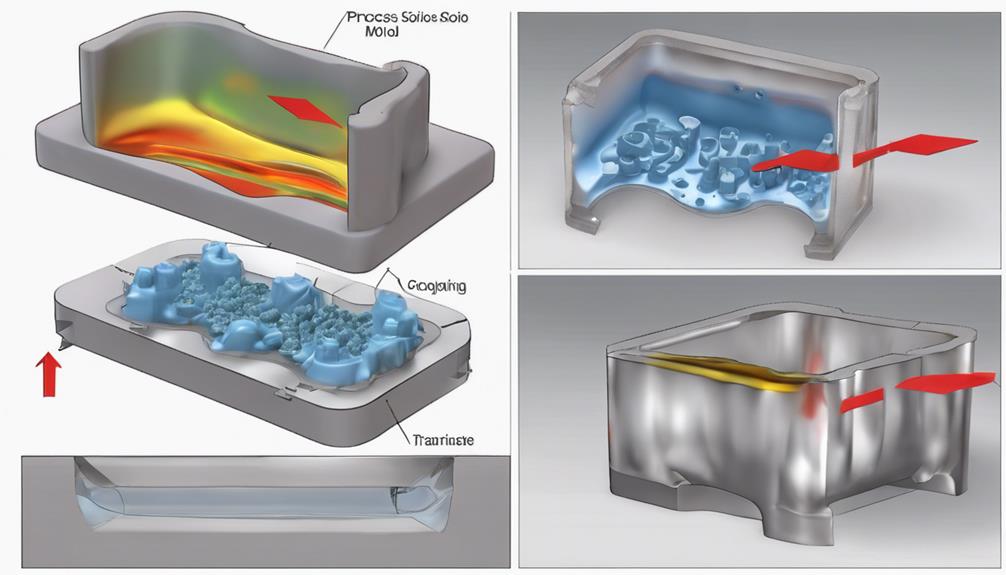
Solidification in the mold plays a critical role in determining the quality and properties of injection-molded plastic components. During this phase, the molten plastic transforms into a solid state within the mold cavity. Here are three key points related to solidification within the mold:
- Cooling Time: The cooling time is important as it guarantees the plastic solidifies completely within the mold. Proper cooling is essential to achieving the desired part properties and preventing defects.
- Dimensional Accuracy: The solidification process directly impacts the dimensional accuracy of the final product. Controlling cooling rates and temperatures is essential in ensuring the part meets the specified dimensions accurately.
- Preventing Defects: Proper solidification is crucial to prevent issues such as warping or structural defects in the molded component. By carefully managing the solidification process, manufacturers can produce high-quality plastic parts with integrity and precision.
Opening the Mold for Releasing
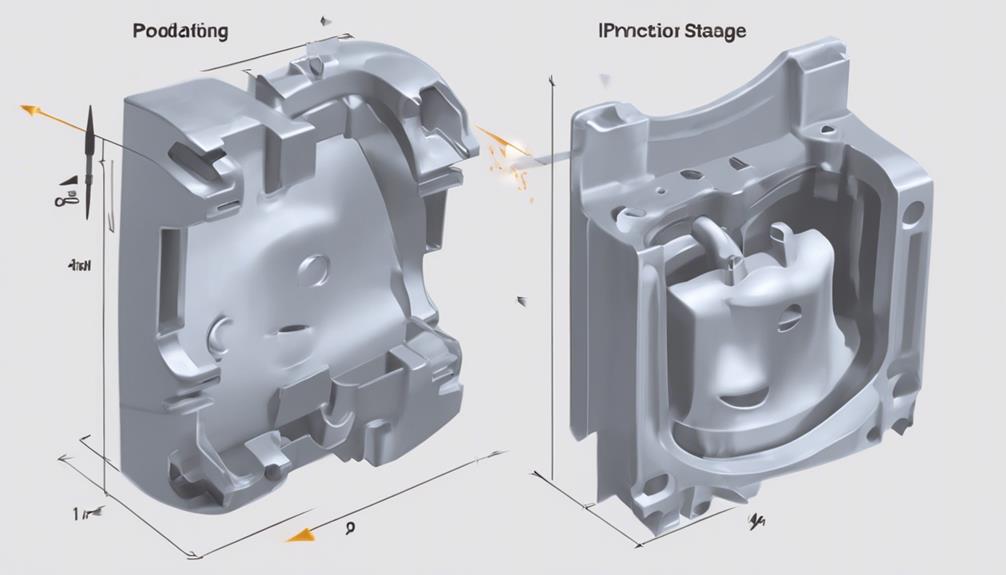
Solidifying within the mold guarantees the cooled plastic component can be released efficiently through a critical step in the injection molding process known as opening the mold. Once the cooling phase is complete, the mold opens in the designated opening direction. This opening direction is carefully planned to facilitate the ejection of the solidified plastic part. Ejector pins, or in some cases ejector plates, are instrumental in this process. These components are part of the ejection system and work by pushing the part out of the mold once it is opened.
Proper alignment and timing of the mold opening are pivotal factors to ensure the part is released smoothly without any damage. The ejection system, comprising the ejector pins and plates, is meticulously designed to safely and efficiently remove the finished plastic component from the mold. This stage is critical in the injection molding process as it marks the shift from a completed part within the mold to its release for further processing or use.
Creating Intricate Plastic Parts
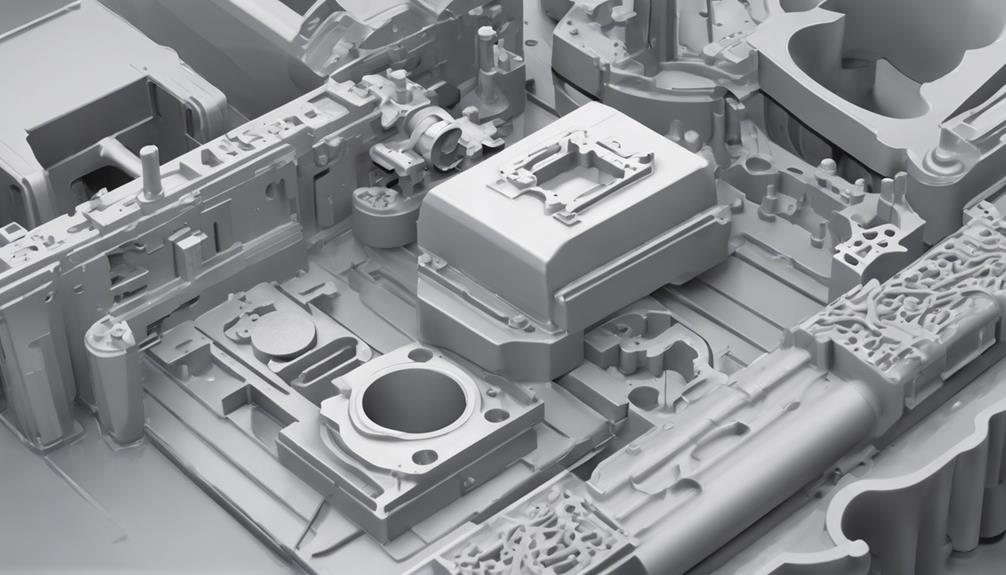
To achieve intricate plastic parts with small tolerances and complex features, injection plastic molding utilizes a precise and detailed process of heating and injecting plastic under pressure. This method allows for the creation of highly detailed components with consistent quality and accuracy.
Key factors contributing to the creation of intricate plastic parts through injection molding include:
- Use of Plastic Pellets: The process starts with plastic pellets, which are melted and injected into the mold cavity to form the desired shape. This guarantees uniform material distribution and precise molding.
- Precision Control: Injection molding machines offer precise control over factors such as temperature, pressure, and injection speed, enabling the production of intricate parts with small tolerances. This level of accuracy is essential for achieving complex geometries and fine details.
- Thermoplastic Versatility: Thermoplastics, known for their ability to be melted and solidified repeatedly, are commonly used in injection molding. Their versatility allows for the creation of intricate parts with varying properties and finishes, making them ideal for a wide range of applications.
Precision and Repeatability Factors
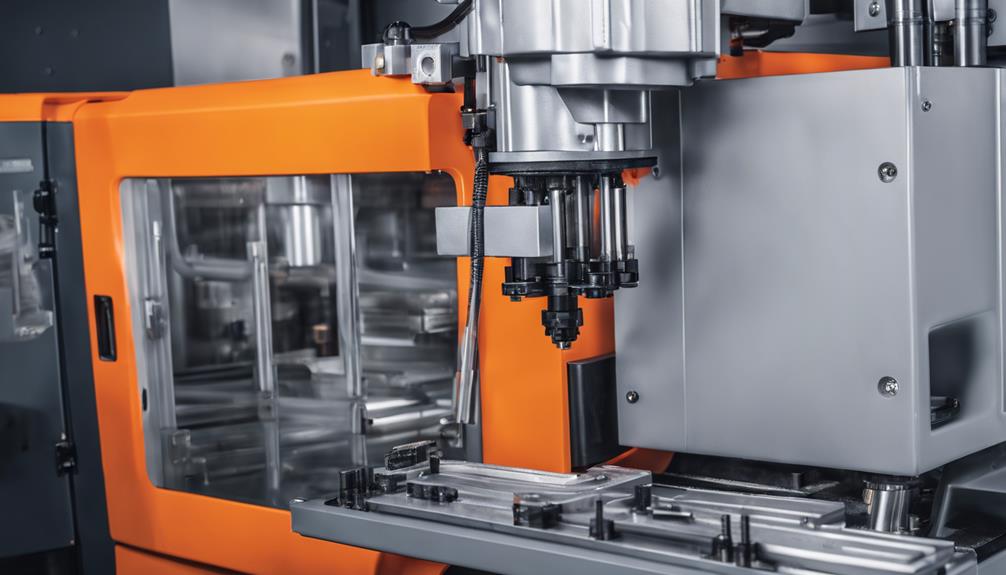
Precision and repeatability factors play an essential role in ensuring the consistent quality and accuracy of injection plastic molding processes. Injection plastic molding offers high precision with tolerances as low as +/- 0.001 inches, guaranteeing uniform part dimensions.
The repeatability of injection molding processes allows for the production of identical parts in large quantities with minimal variation. Tight process controls and monitoring systems are implemented to maintain precision and repeatability throughout the injection molding cycle.
Advanced technologies such as automation and robotics further enhance these aspects by minimizing human error and ensuring consistent results. Quality assurance measures, including inspection systems and statistical process control, are integral in upholding the precision and repeatability of injection molding outcomes.
Role of Rotating Screw
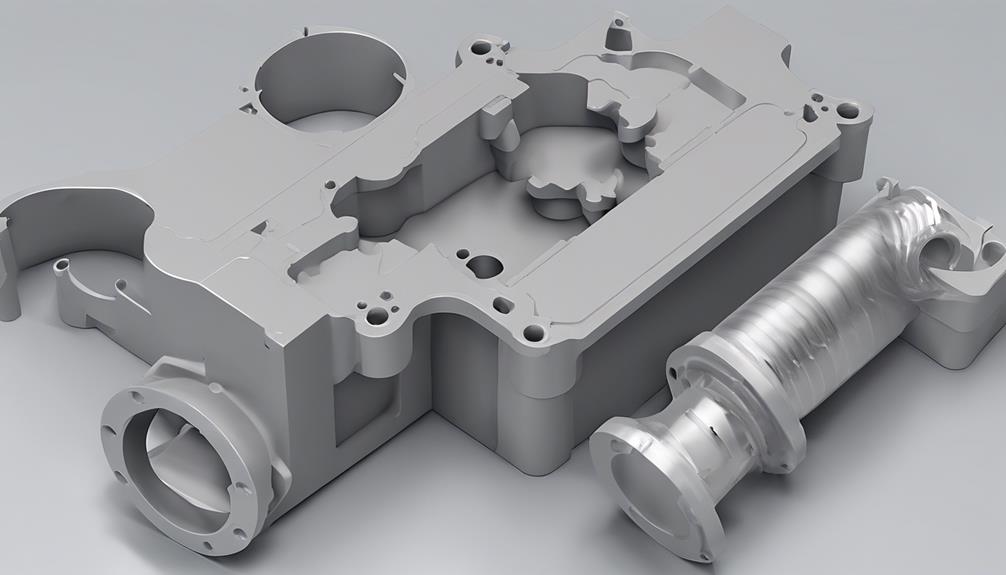
The rotating screw in injection molding machines is a vital component responsible for melting plastic resin pellets efficiently. Its mechanism guarantees the homogenization of the molten material by applying pressure, controlling temperature, and promoting uniform mixing.
Screw Rotation Mechanism
The pivotal function of the rotating screw in injection plastic molding lies in its role of facilitating the efficient melting and mixing of plastic resin pellets. The screw rotation mechanism is important for the injection molding process, influencing various aspects of the operation.
Here are key points regarding the screw rotation mechanism:
- Exerts pressure to push molten plastic through the check valve and into the mold cavity.
- The speed and rotation of the screw are essential for controlling the flow and consistency of the melted plastic.
- Plays a significant role in achieving precise and uniform distribution of the molten plastic within the mold.
Proper maintenance and calibration of the rotating screw are crucial for ensuring the efficiency and quality of injection molding processes.
Material Homogenization Process
To optimize the material homogenization process in injection plastic molding, the rotating screw functions as a key component in uniformly melting and mixing the plastic resin for consistent mold filling. The screw rotation speed and pressure control are critical factors in ensuring effective material homogenization.
As the screw rotates, it applies heat, friction, and shear force to the plastic material, facilitating its uniform melting and mixing. This molten plastic is then pushed through a check valve into the mold cavity, maintaining consistent material properties throughout the process.
Pressure and Temperature Control
Playing an essential role in injection plastic molding, the rotating screw precisely regulates pressure and temperature for the effective melting and injection of plastic resin. The rotating screw achieves this through the following mechanisms:
- Heat Application: The screw applies heat to the plastic resin, facilitating its melting process.
- Friction Generation: By creating friction within the resin, the screw helps in maintaining the necessary temperature for proper melting.
- Shear Force Generation: The screw generates shear force, ensuring that the plastic resin is uniformly melted and ready for injection.
Through these actions, the rotating screw plays a critical role in controlling pressure and temperature, ultimately contributing to the success of the injection molding process.
Efficient Melting and Injection
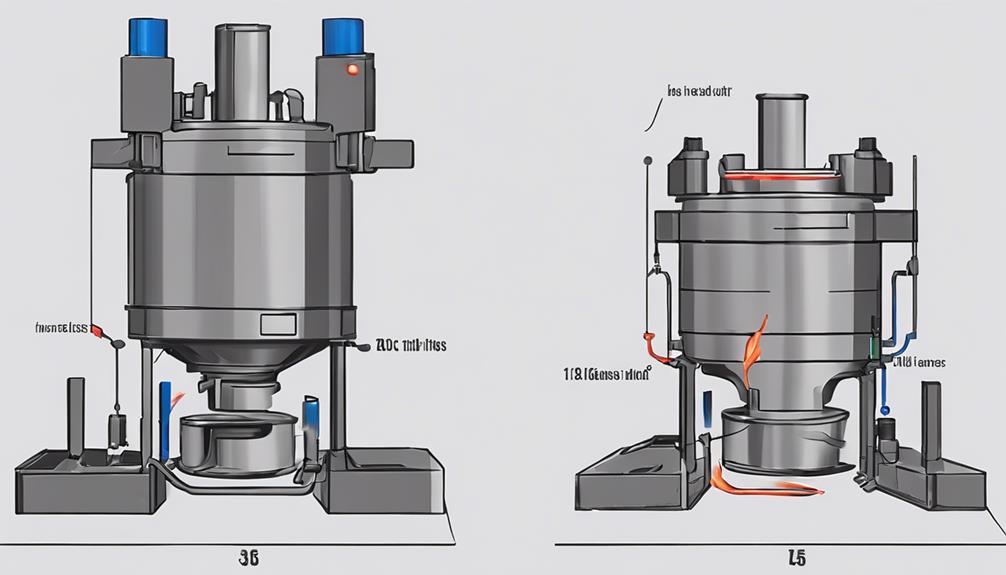
Effectively managing the melting and injection processes in plastic molding is essential for achieving high-quality and consistent results. In injection molding, the plastic pellets are heated and melted using hydraulic or electric power within the injection molding machine. Precise temperature control is important during this stage to guarantee the plastic reaches the ideal viscosity for injection into the mold cavity.
The melted plastic is then injected into the mold cavity through a gate system under controlled pressure. This pressure is critical to ensure complete filling of the mold cavity with the molten plastic, resulting in a well-formed final product. After injection, proper cooling of the plastic inside the mold is necessary to solidify the material before ejection for finishing processes. Efficient cooling helps in maintaining the shape and structural integrity of the molded part.
Smooth Manufacturing Process
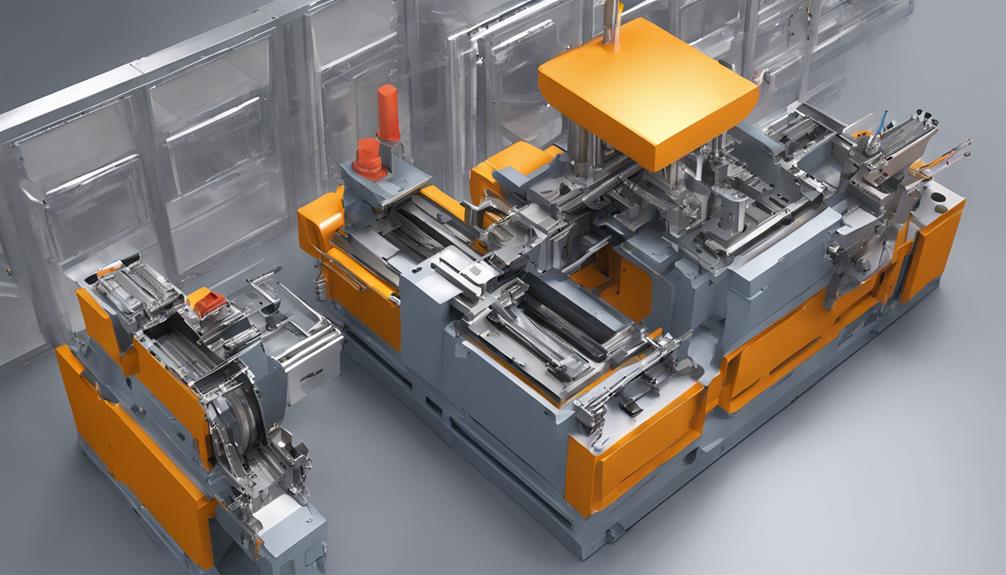
The essential manufacturing process of injection plastic molding begins with the injection of melted plastic into a precisely designed mold cavity. This phase is vital as it determines the shape and intricacies of the final product, ensuring accuracy and consistency in each piece.
Following injection, the plastic is cooled within the mold, solidifying it before ejection, resulting in high-quality, uniform plastic components.
Melted Plastic Injection
During the melted plastic injection process in injection plastic molding, plastic is transformed into a liquid state through heating before being precisely injected into the mold cavity. This step is essential for ensuring consistent part quality in the manufacturing process.
The molten plastic fills the mold cavity to replicate the desired shape accurately. Key points to note about melted plastic injection include:
- Transformation of plastic into a liquid state through controlled heating.
- Precise injection of the molten plastic into the mold cavity.
- Ensuring consistent part quality through accurate replication of the desired shape.
These factors contribute to the smooth and efficient production of high-quality plastic components in injection plastic molding.
Mold Shaping Process
With the completion of the melted plastic injection stage, the focus shifts towards the meticulous mold shaping process in injection plastic molding. Here, the creation of precise mold cavities and cores defines the intricacies of the final product shape. Advanced CAD and 3D printing technologies are employed to guarantee accuracy in design.
The mold cavity and core play a critical role in shaping the injection-molded part, determining its form and features. Materials such as steel and aluminum are commonly used to fabricate durable mold tools essential for the mold shaping process.
Ensuring proper mold shaping is paramount for achieving consistent and high-quality plastic components during the injection molding process.
Cooling and Ejection
Amidst the injection plastic molding process, the critical stages of cooling and ejection come into play, ensuring the efficient solidification and smooth removal of plastic components from the mold.
Proper cooling time is essential for solidifying the plastic within the mold cavity efficiently, contributing to the part's shape and properties. The cooling phase plays a significant role in preventing warping or deformation in the final plastic component.
Ejection systems in injection molding are designed to facilitate the smooth removal of cooled plastic components from the mold, ensuring a seamless manufacturing process from start to finish. Controlled cooling conditions are essential for maintaining the quality and accuracy of the injection molded parts.
Consistent Production Benefits
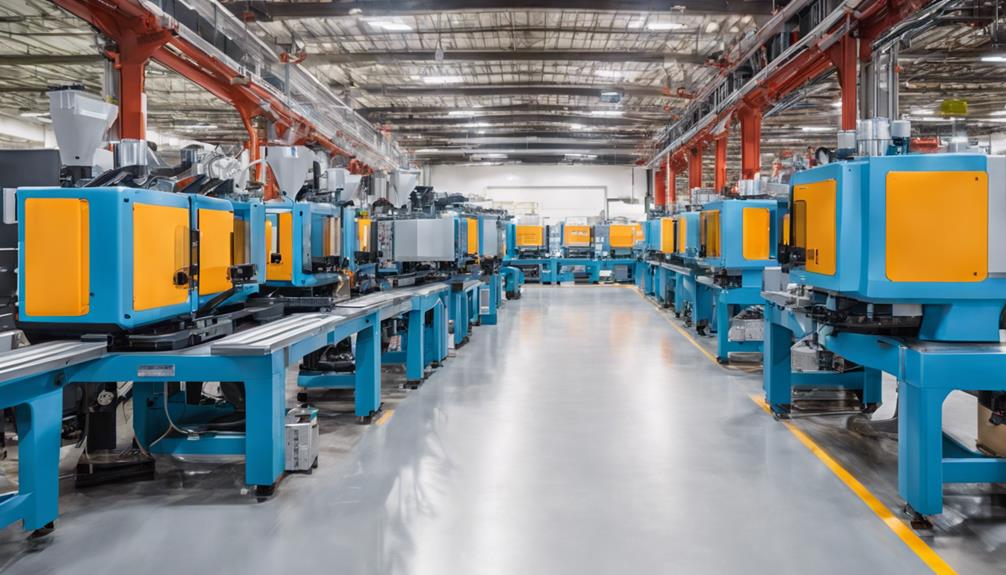
Injection plastic molding offers a multitude of important production benefits through meticulous control of critical parameters. By maintaining precise control over key aspects of the injection molding processes, manufacturers can guarantee high-quality production runs with minimal variation. Quality control measures play a vital role in achieving consistent production by monitoring and verifying that each part meets the required specifications. This attention to detail results in high repeatability and reliability in manufacturing plastic components.
One of the significant advantages of consistent production in injection plastic molding is the reduction of waste. With minimal variation in quality, there is less likelihood of producing defective parts that would need to be discarded, leading to cost savings. Additionally, the predictability and stability of the process enable faster cycle times, increasing overall efficiency. Injection molding machines have the capability to produce thousands to millions of parts with consistent quality, making it a preferred method for mass production in various industries.
Detailed Parts Production
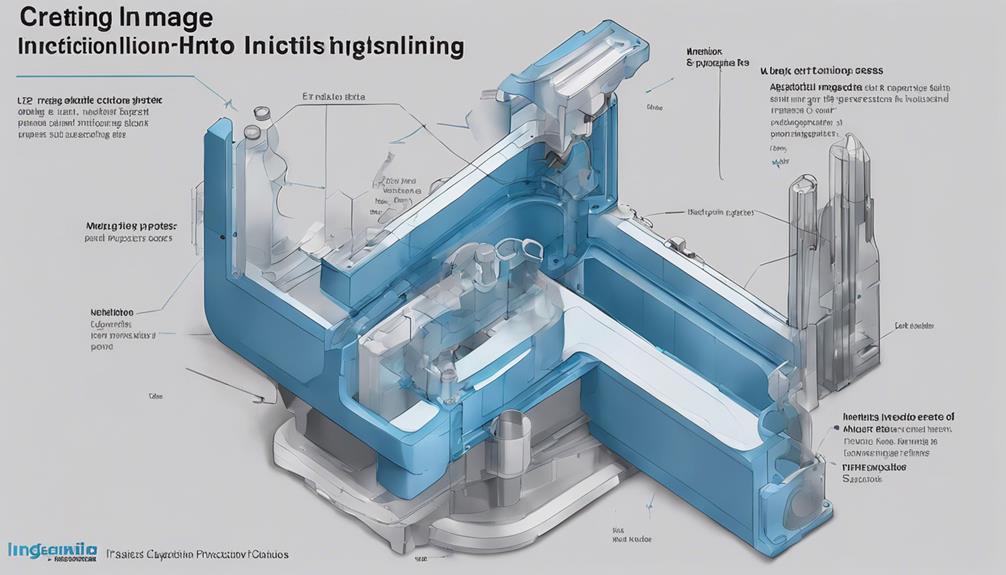
Detailed parts production in injection plastic molding involves the meticulous creation of intricate components through the precise injection of molten plastic into a mold cavity. The process of transforming molten plastic into a final part requires careful attention to various process parameters to guarantee the desired outcome.
Here are three key aspects of detailed parts production in injection plastic molding:
- Solidification Process: Once the molten plastic is injected into the mold cavity, it undergoes a cooling process. This cooling phase is critical as it allows the plastic to solidify and take on the shape of the mold.
- Maintaining Process Parameters: Controlling factors such as temperature, pressure, and cooling time is essential during the production of detailed parts. These parameters need to be precisely monitored to achieve consistent and high-quality results.
- Ejection of Final Parts: After the plastic solidifies within the mold, the ejection system plays a crucial role in removing the final parts accurately. This step is important for further processing or finishing of the components.
Importance of High Pressure
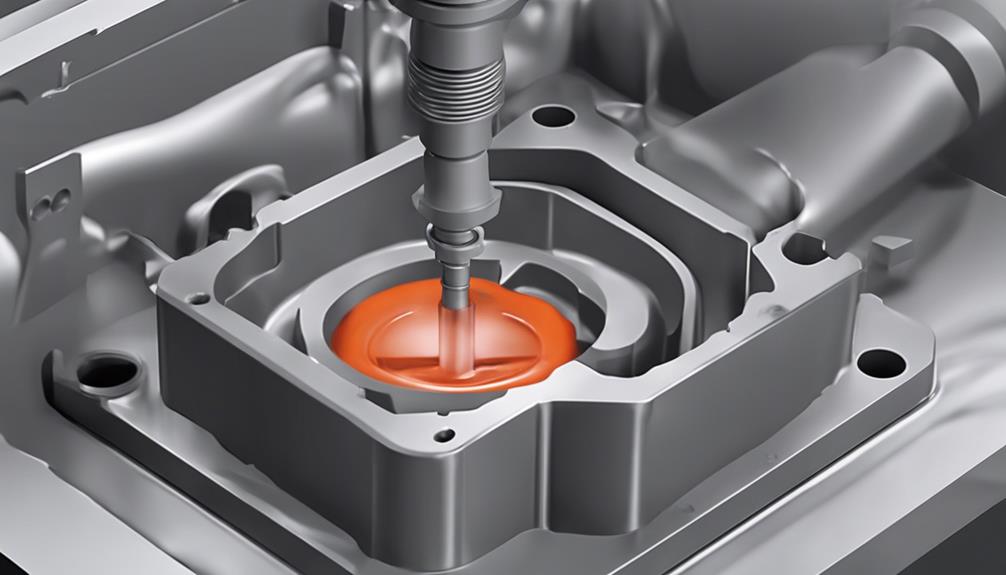
Utilizing high pressure in injection plastic molding is essential for ensuring the thorough and uniform filling of the mold cavity with molten plastic. The application of high pressure serves to eliminate potential air pockets and voids within the final molded part, which is vital for maintaining the structural integrity and quality of the component. By controlling and maintaining high pressure levels throughout the injection process, manufacturers can consistently produce precise and accurate molded parts.
Moreover, high pressure plays a pivotal role in preventing premature solidification of the plastic material. This characteristic enables the molten plastic to flow smoothly and conform precisely to the intricate details of the mold, contributing to the overall accuracy and intricacy of the final plastic components. The ability to uphold elevated pressure levels during injection molding operations is fundamental for achieving the desired outcomes in terms of part quality, dimensional accuracy, and surface finish.
Frequently Asked Questions
What Are the 5 Steps of Injection Molding?
The five key steps of injection molding are: clamping, injection, dwelling, cooling, and ejection.
Clamping involves securely closing the mold to prevent any material leakage.
Injection introduces the molten material into the mold cavity.
During dwelling, the material cools and solidifies to take the shape of the mold.
Cooling guarantees the part is completely solidified.
Ejection then removes the finished part from the mold for further processing.
Is Plastic Injection Molding Difficult?
Plastic injection molding can present challenges due to the need for meticulous control of parameters such as temperature, pressure, and cooling rates.
Preparing the right thermoplastic material and mold design demands expertise to guarantee seamless production.
Skilled toolmakers play a critical role in fabricating intricate molds with features like sprues, runners, and gates.
While the process can be complex, with proper training and attention to detail, plastic injection molding can be effectively executed to yield high-quality products.
What Is the Basic Knowledge of Injection Molding?
Injection molding is a complex process that requires a deep understanding of various factors such as materials, design, and production parameters. Basic knowledge of injection molding includes grasping thermoplastic properties, mold design principles, and the significance of process control.
Familiarity with injection molding machinery, tooling, and quality control measures is essential for ensuring efficient and successful manufacturing of precision parts. This foundational understanding forms the basis for mastering the intricacies of injection molding.
What Is the Difference Between Injection Molding and Casting Plastic?
Injection molding and casting plastic differ in precision, production scale, and process speed.
Injection molding offers high precision and consistency, suitable for mass production and intricate designs due to its shorter cycle times.
On the other hand, casting plastic is ideal for simpler shapes and smaller production runs, with a slower curing process.
These differences make injection molding more cost-effective for large-scale manufacturing compared to casting plastic.
Conclusion
To sum up, plastic injection molding involves a precise and high-pressure process of heating plastic granules, injecting molten material into a mold, and solidifying the material to produce detailed parts consistently.
This manufacturing process is essential for creating a wide range of products with intricate designs and smooth finishes.
The efficiency and accuracy of injection molding make it a paramount method for producing a myriad of products with unparalleled precision and speed.
